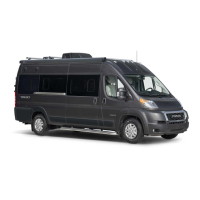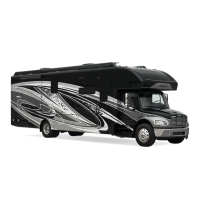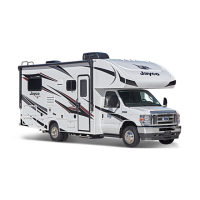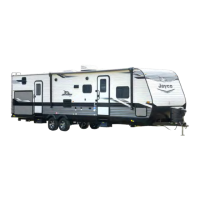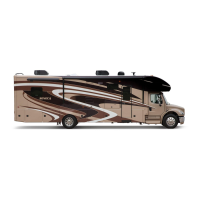90
Salt and other chemicals that are spread on winter roads in some geographical areas can have
a detrimental eect on the recreation vehicle’s underbody.
Take special care to remove mud or other debris that could trap and hold salt or moisture.
After washing your recreation vehicle, wipe o all water drops from the rubber parts around
the slideout and doors.
Wax your recreation vehicle once or twice a year, or when painted surfaces do not shed water
well. Use a soft cloth to apply a small amount of wax to the painted surfaces. After the wax
has dried, polish the recreation vehicle with a dry, soft cloth.
Do not wax your recreation vehicle in direct sunlight. Wax it after the surfaces have cooled.
Do not apply wax to any area having a at black nish as it can cause discoloration. If the
nish has been stained with wax, wipe o the area with a soft cloth and warm water. When
waxing the area around the various openings, do not apply any wax on the weather strip. If
it is stained with wax, the weather strip cannot maintain a weatherproof seal around the
opening.
If painted surfaces have been severely damaged and have lost their original luster and color
tone, polish the surface lightly with a ne polishing compound. Avoid limiting your polish-
ing to the damaged surface only; polish a somewhat wider area, moving the polishing cloth
in one direction. After polishing, ush the compound from the surface and apply a coat of
wax to regain a beautiful luster.
To prevent corrosion, touch up small cracks and scratches in the paint coat as soon as pos-
sible with touch-up lm or paint. Carefully check the body areas facing the road and the
tires for damage to the paint coat caused by ying stones, etc.
Use a sponge or chamois to clean plastic parts. Use warm water and a soft cloth or chamois
to remove any white residue from dark colored plastic surfaces. Do not use a scrubbing
brush, other hard tools, or wax containing abrasives as they may damage the plastic surface.
Do not use waxes containing high-abrasive compounds. Such waxes re-
move rust and stains eectively from the paint work, but they are also
harmful to the luster of the painted surface since they scrape o the coat-
ing. Further, they are detrimental to glossy surfaces, such as the grille,
garnish, moldings, etc. Do not use gasoline or paint thinners to remove
road tar or other contamination to the painted surface.
Do not use a buer and a bung compound as it may damage the exterior
surface. Please contact a professional paint body shop for assistance.
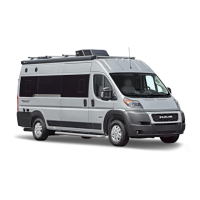
